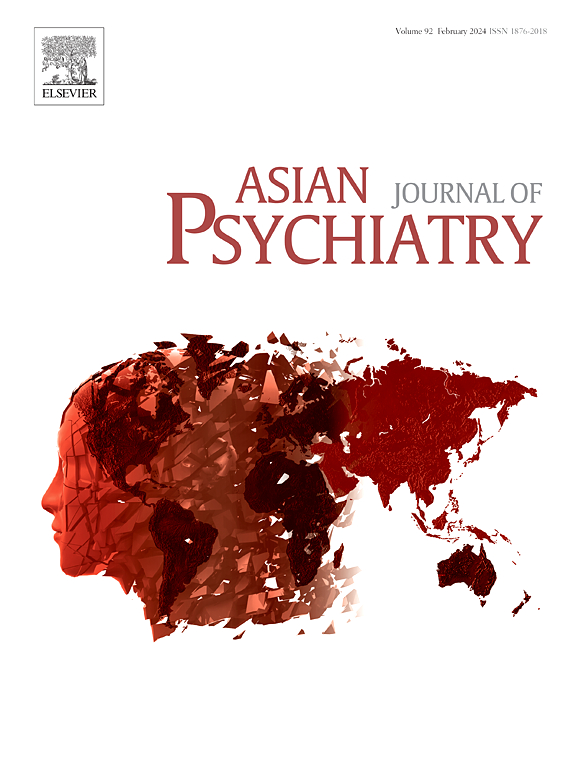双相情感障碍患者左脑专门化程度降低及其与神经递质和遗传谱的关系:一项纵向研究
IF 4.5
4区 医学
Q1 PSYCHIATRY
引用次数: 0
摘要
大脑专业化在人类行为和认知中起着至关重要的作用。先前的研究表明精神疾病的异常专业化;然而,双相情感障碍(BD)的专业化模式和药物对这些变化的影响尚不清楚。根据Crow关于语言在精神病起源中的关键作用的假设,双相障碍患者可能表现出异常的语言相关专业化。在这里,我们的目的是探讨脑内递质在药物治疗前后的脑特化变化。基于静息状态图像的自主指数被用于评估82名bdp和88名健康对照(hc)的大脑专一性。43例bdp患者接受了3个月的药物治疗,完成了随访。以自主指数为输入,采用支持向量回归(SVR)分析预测治疗反应。此外,我们还进行了自主指数与遗传谱或神经递质受体/转运体密度之间的交叉样本相关性分析。基线时,bdp在左侧颞中回(MTG)的自主指数相对于hc降低。然而,在药物治疗后没有观察到明显的变化。采用自主指数,SVR模型可以预测bdp的治疗反应,相关系数为0.705。大脑特化模式与6个基因和神经递质相关,包括多巴胺能(D1R、D2R和DAT)和血清素能(5-HT2A)的传递。与Crow的假设一致,我们发现bdp的语言网络(LN)的一个关键节点的大脑专门化程度降低。我们还提供了BD潜在的遗传和生物学机制。本文章由计算机程序翻译,如有差异,请以英文原文为准。
Decreased left brain specialization in bipolar disorder patients and its association with neurotransmitter and genetic profiles: A longitudinal study
Brain specialization plays a crucial role in human behavior and cognition. Previous studies have suggested abnormal specialization in psychiatric disorders; however, the specialization patterns of bipolar disorder (BD) and the effects of medication on these changes remain unclear. According to Crow’s hypothesis regarding the key role of language in the origin of psychoses, BD patients (BDPs) may exhibit abnormal language-related specialization. Here, we aimed to explore brain specialization alterations of BDPs before and after pharmacological treatment. The autonomy index, based on resting-state images, was used to assess brain specialization in 82 BDPs and 88 healthy controls (HCs). Among patients, 43 BDPs who underwent 3 months of pharmacological treatment completed the follow-up. Using autonomy index as input, support vector regression (SVR) analysis was conducted to predict treatment response. Additionally, we conducted cross-sample correlation analyses between autonomy index and genetic profiles or the densities of neurotransmitter receptors/transporters. At baseline, BDPs exhibited reduced autonomy index in the left middle temporal gyrus (MTG) relative to HCs. However, no significant alterations were observed following pharmacological treatment. Using autonomy index, the SVR model could predict treatment response for BDPs with a correlation coefficient of 0.705. Brain specialization patterns were correlated with six genes and neurotransmitters including dopaminergic (D1R, D2R, and DAT) and serotonergic (5-HT2A) transmission. In line with Crow’s hypothesis, we found reduced brain specialization in a key node of the language network (LN) in BDPs. We also provided potential genetic and biological mechanisms underlying BD.
求助全文
通过发布文献求助,成功后即可免费获取论文全文。
去求助
来源期刊

Asian journal of psychiatry
Medicine-Psychiatry and Mental Health
CiteScore
12.70
自引率
5.30%
发文量
297
审稿时长
35 days
期刊介绍:
The Asian Journal of Psychiatry serves as a comprehensive resource for psychiatrists, mental health clinicians, neurologists, physicians, mental health students, and policymakers. Its goal is to facilitate the exchange of research findings and clinical practices between Asia and the global community. The journal focuses on psychiatric research relevant to Asia, covering preclinical, clinical, service system, and policy development topics. It also highlights the socio-cultural diversity of the region in relation to mental health.
 求助内容:
求助内容: 应助结果提醒方式:
应助结果提醒方式:


